| Title | Pages |
|---|---|
| Transport Characteristics of Selected Dyes Through Track-Etched Multiporous Pet Membranes We have investigated the transport properties of track-etched poly(ethylene terephthalate) (PET) membranes in order to pursue possible applications for effective separation and sensing purposes. We have obtained cylindrical and conical nanopores on PET membranes using symmetrical and asymmetrical track-etch methods, respectively. We have used the fabricated nanopores for the transport of charged dye molecules. Effect of applied potential, temperature and pore geometry was shown for crystal violet dye. We have also investigated the transport of methyl orange and shown negatively charged carboxylate groups on the PET nanopore walls along with applied potential enhanced the selective transport of cations. The temperature and the conical geometry were also found to promote the transport of cations. 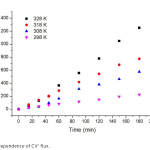
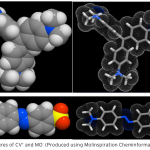

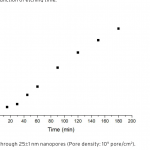
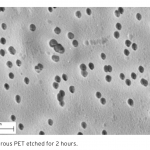
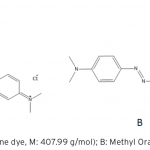
|
1 - 11 |
| Determination of Acidic Dissociation Constants of Chlorthalidone and Terbutaline in Water Using DFT and Ab Initio Methods In the present study, pKa values of both drug called Chlorthalidone and Terbutaline were determined in aqueous solution. For this purpose, the B3LYP calculation with the 6-31+G(d) basis set was utilized. The reactions and equilibria that possess a high hydrogen-band-donor capability and constitute the indispensable theoretical basis to calculate the acidity constants of Chlorthalidone and Terbutaline, are shown. To analyze the formation of intermolecular hydrogen bonds between the existent species and water molecules, Tomasi’s method was used. In this way, it was determined that in alkaline aqueous solutions the cation, anion, and neutral species of Chlorthalidone and Terbutaline are solvated with one, two, three, and four molecules of water, respectively. To proceed, the calculated pKa were compared with the experimental values, which there is comparable agreement between them. The resulting data illustrated that the method was likely to be useful for the prediction of pKa values in aqueous solution. 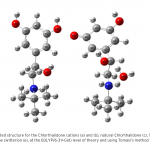
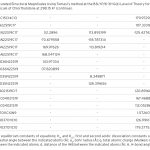

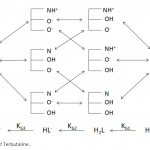
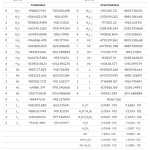
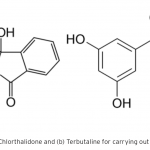
|
13 - 29 |
| Parietaria rechingeri Chrtek (Urticaceae); A New Record for Flora of Turkey Parietaria rechingeri (Urticaceae) is described as a new record to the Flora of Turkey (C9, Şırnak). Detailed morphological description, photographs and distribution map of this new record has been given in this article. 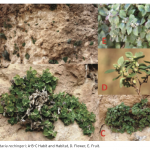
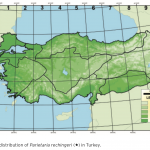
|
31 - 34 |
| Reprogramming Human Melanocytes and Melanoma Cells with Yamanaka Factors The generation of induced pluripotent stem (iPS) cells from somatic cells showed that cell fate could be manipulated by simply introducing a few transcription factors. The differentiation potential of iPS cells has uncovered a wide range of potential applications, including disease modeling, drug screening and regenerative therapy. In this study, we aimed to induce reprogramming of human melanocytes and melanoma cell lines via Sendai viral vectors encoding Yamanaka factors. Following transfection, pluripotent stem cell colonies have emerged in the melanocyte cultures, as evident by phase-contrast and fluorescence microscopy images. However, only cell clusters which were not positive for pluripotency markers were obtained in the melanoma cell cultures. This proved that there are differences between healthy and cancer cell reprogramming. Basal gene expression of Yamanaka factors, pluripotency markers and tumor-suppressor genes have been identified in order to understand the different responses for cell reprogramming in melanocytes and cancer cell lines. Future studies that will allow efficient reprogramming of cancer cells can improve our knowledge about cancer biology and therapy 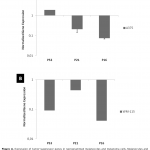
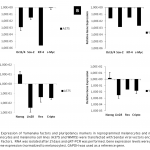
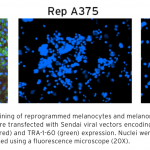

|
35 - 41 |
| Synthesis and Characterisation of a New Hydrophilic Interaction/Reversed Phase Mixed-Mode Chromatographic Stationary Phase Anovel multifunctional stationary phase based the amide-silica was synthesised starting from L-isoleucine and 2-aminoacetanilide. Hereby, compounds 1, 2, 3 and 4 were synthesised for the first time and 1, 2 and 4 were identified. The stationary phase was synthesised by a reliable and repeatable method and characterized by elemental analysis, solid state 13C NMR, scanning electron microscope (SEM), and Brunauer, Emmett and Teller (BET). This stationary phase possess four amide groups as polar cites, phenyl ring as aromatic non-polar cite and isopropyl as an aliphatic non-polar cite. Therefore, it can act as both hydrophilic interaction (HILIC) and reversed phase (RPLC) chromatographic stationary phase. The stationary phase has also chirality and can be used in enantioseparation of racemic compounds in normal phase chromatography (NPLC). 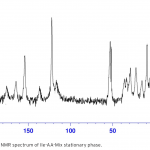

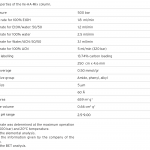
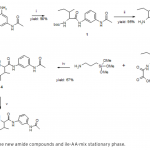
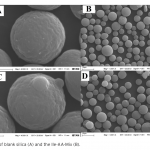
|
43 - 52 |
| Radiation Synthesis of Molecularly Imprinted Hydroxyethylmethacrylate-based Matrices for Glucose Recognition In this study, 2-hydroxyethyl methacrylate (HEMA) was used as functional monomer and diethylene glycol diacrylate (DEGDA) and polyethylene glycol (200) diacrylate (PEG(200)DA) were used as crosslinking agents to imprint D(+)glucose. D(+)glucose imprinted polymers were prepared in the presence of dimethyl sulfoxide (DMSO) /isopropyl alcohol (IPA) (3/1, v/v) at room temperature, in the air by radiation-induced polymerization/ crosslinking. The control polymers were synthesized by the same procedure in the absence of D(+)glucose. In order to evaluate the recognition and separation properties of the imprinted system high performance liquid chromatography (HPLC) experiments were carried out where β (-) lactose, D(+)glucose and glycerol were used as analytes. To increase the affinity of the template to the stationary phase polarity of the mobile phase was decreased by the addition of acetonitrile into water. Optimum composition of acetonitrile/water (1/5 v/v) was determined according to the swelling experiments. The sizes of the cavities in the polymeric networks were determined by positron annihilation lifetime spectroscopy (PALS). The average radii of cavities were found as 0.254 and 0.279 nm for freeze-dried imprinted polymers prepared by using PEG(200)DA after swollen in water and acetonitrile/water mixture (1/5 by volume), respectively. 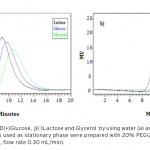
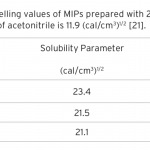
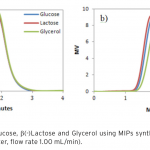
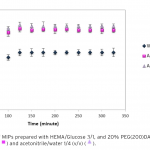
|
53 - 60 |
| Modification of Functional Polyesters Bearing Norbornene Moieties via Olefin Metathesis Reactions In this study, unsaturated functional polyester derivatives were synthesized via polycondensation reactions of 5-norbornene-2,3-dicarboxylic anhydride and 1,6-hexanediol. Functional unsaturated polyesters were modified using methyl acrylate as ring opening/cross-metathesis reaction partner. The solubility and hydrophobic/hydrophilic character of polyester was tuned by integrating allyl end capped poly(ethyleneglycol) by ring opening/cross-metathesis reactions. Norbornene moiety of unsaturated polyesters allowed us to use ring opening metathesis polymerization reactions to form side-chain poly(norbornene) on main polyester chain using Grubbs 1st, 3rd and Hoveyda-Grubbs 2nd generation catalysts as initiators, resulting in gel-like materials 
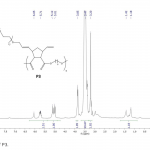
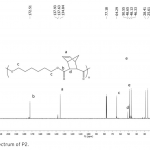
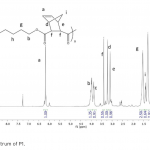
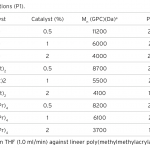
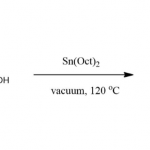
|
61 - 68 |
| Controlled Release of Vitamin C from Chitosan Nanoparticles This work is consisted of two parts. The first was the synthesis and characterization of nanoparticles (ChNPs) from Chitosan, a natural biopolymer. In the second part, preparation of Vitamin C loaded ChNPs and release of vitamin C from the loaded nanoparticles were investigated. ChNPs were synthesized according to the ionic gelation method and sodium tripolyphosphate (TPP) was used as the crosslinking agent. The particle size distribution of the synthesized ChNPs was determined by using Zeta Sizer. Surface morphologies and crystal structures of the nanoparticles were investigated by Scanning Electron Microscopy (SEM) and X- ray diffraction (XRD) analysis, respectively. Structural analysis and thermal properties of ChNPs were also investigated by Fournier Transform Infrared Spectroscopy (FTIR) and thermogravimetric analysis (TGA), respectively. Release porofile of the Vitamin C loaded nanoparticles at same time were determined. As a result, average particle size of the ChNPs was measured as 10 nm and loading efficiency of the ChNPs was calculated as 86% with very high vitamin C concentration. Finally, the release mechanism of vitamin C from nanoparticles was determined to be controlled by diffusion and swelling. 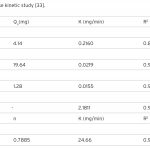
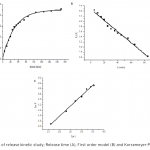
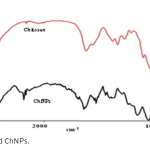

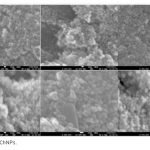
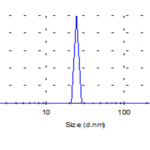
|
69 - 77 |
| DFT Studies of Carbon Structures Supported Vanadia Catalysts for Oxidative Dehydrogenation of Propane: Kinetic and Thermodynamic The detailed mechanism for oxidative dehydrogenation of propane on the 1VO4(CH3)3 surface has been studied in depth with density functional theory (DFT) calculations at the B3LYP level and standard split-valance basis set, 6-31+G*. Monomeric vanadia specie was considered and modeled as catalysis. In addition, the mechanisms of the two complete catalytic cycle, involving the regeneration of the reduced catalyst using O2 gaseous have been reported. The reaction proceeds in two subsequent steps which at the first, one hydrogen abstracting by the vanadium of V= O1 group with about 48.35 cal/mol activation energy is the rate determining step. Subsequently, second intermediate has been formed through a bond formed between the propyl radical and O2 atom (V-O2). In continue, the O1 atom abstracts one hydrogen atom from the methyl group with a 131.63 kcal/ mol barrier to form propene by passing to second transition state. The results of our calculations have found that all the reactions involve vanadyl oxygen (V=O1), with the bridging oxygen (V-O-C) serving to stabilize the isopropyl radical intermediate. 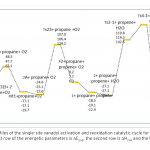
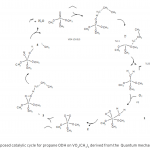
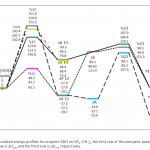
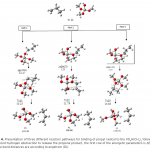
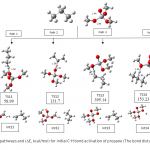
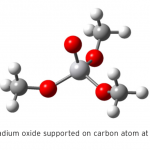
|
79 - 89 |
| Production of Thermostable α-Amylase Through Solid State Fermentation (SSF) by Using Thermophilic Anoxybacillus sp. The production of extracellular α-amylase (1,4-α-D-glucan glucanohydrolase, EC 3.2.1.1) by a newly isolated thermophilic bacterium Anoxybacillus sp. was studied in solid state fermentation (SSF). Bacterial strain was isolated from a thermal spring of Ömer, Afyonkarahisar in Turkey. Agricultural wastes such as banana husk, wheat bran, rice husk, apple bark, orange bark, maize oil cake, lentil bran and pistachio shell were used for α-amylase production as solid substrates. Growth on rice husk gave the highest α-amylase activity. The maximum enzyme activity obtained was 3.628 U/mg of under optimum conditions of an fermentation time of 48 h, an incubation temperature of 60°C, a pH of 6.0, a substrat particle size 1.500 μm, an initial moisture level of 60% and an inoculum level of 40% (v/w). 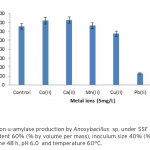
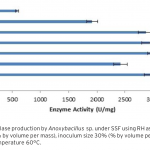
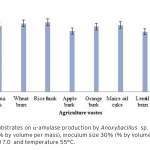
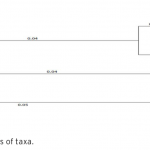
|
91 - 99 |
| Trichoderma citrinoviride: A Potent Biopriming Agent for the Alleviation of Salt Stress in Maize The rapid increase in global population and industrial pollution pose severe environmental threats to agriculture that are exacerbated by salt stress. Molecular characterization of new fungal isolates and assessment of their impact on agriculture might be an eco-friendly approach to modulating salt tolerance. Herein, fungal seed biopriming was conducted on salt (NaCl) stressed maize in a dose-dependent manner. Genetic lineages of fungi were identified using well-known fungal ITS (internal transcribed spacer) barcodes that revealed similarity to the Trichoderma citrinoviride (T11C) species. Fv/Fm, ETR and qP were recorded as close to optimum in bioprimed maize plants after application of salt stress. NPQ (nonphotochemical quenching) decreased slightly in respective groups. Higher photosynthetic pigment contents were also detected. T11C seed biopriming decreased the lipid oxidation remarkably under salt stress. SOD, GPX, GR and CAT activities were not found to be significantly induced in the roots or leaves of T11C after biopriming. However, higher RWC (relative water content), soluble protein and proline were measured in bioprimed test groups treated with high salt stress, demonstrating increased osmoregulatory capacity. Our ongoing research is directed toward developing powdered fungal biopreperations to assay multiple stress tolerances in agriculture for agro- economically important cereals such as maize. 
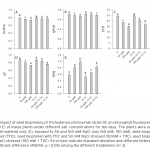

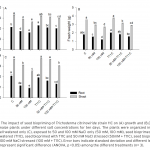
|
101 - 111 |
| Functional Polysaccharides Blended Collagen Cryogels Researches investigate new types of scaffolds for tissue engineering and regenerative medicine applications to support cell proliferation and growth as well as tissue repair and regeneration. Although, there are several types of polymeric materials and various kinds of preparation techniques are already used today; there is still no consensus on the answer of the question “what is the best scaffold for tissue repair and regeneration?”. Cryogels, which is a kind of hydrogels and, cryogelation, which is the technique for cryogel preparation, are rather new for tissue engineering applications. Here in this study, dextran and carboxymethyl cellulose functional polysaccharides blended collagen cryogels were prepared and characterized by chemical, structural and biological evaluations. Results show that, these collagen cryogels with their polysaccharides functional components have proper chemical and thermal characteristics and show good bio and hemo- compatibility. Therefore, these cryogels can be used as a candidate scaffold for tissue engineering and regenerative medicine applications. 
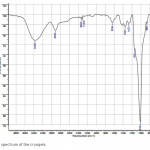
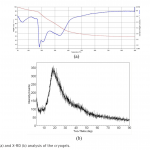
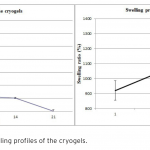
|
113 - 120 |
| Assessment of the Cytotoxicity of Melia azedarach L. Extracts on Human Adipose-derived Mesenchymal Stem Cells In this study, aqueous extracts of Melia azedarach L. green fruit and leaves were obtained using two different extraction methods. The extraction yields of the green fruit and leaves were found as 24.11% and 37.98% for the infusion method; 17.76% and 27.00% for the rotating method, respectively. The total phenolic content, related to the infusion method, was ascertained for green fruit extract 173.67±10.84 mg Gallic Acid Equivalent (GAE)/g dry weight and leaf extract 312.33±9.81 mg GAE/g dry weight. In other respects, antioxidant activity related to the infusion method was determined for green fruit extract 172.51±13.23 mg Trolox/L and leaf extract 569.16±10.41 mg Trolox/L. Gas chromatography-mass spectrometry (GC-MS) analysis was performed to identify the chemical composition of the extracts. The cytotoxicity levels of the extracts were assessed on human adipose-derived mesenchymal stem cells (hAMSCs) using commercially available XTT assay. Consequently, it has been found that the green fruit extract has more cytotoxic activity than the leaf extract on hAMSCs. 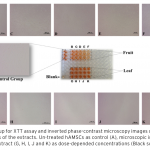
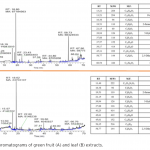

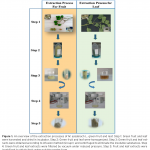
|
121 - 128 |
| The Study of Genetic Parameters Ecologically Stable Mulberry Silkworms Breeds on Different Conditions For the first time by adaptive selection have created new high viable and productive hybrid lines suitable for the climatic conditions of Ganja-Gazakh region. Experiments were carried out in 2 different conditions. Thus the results of the studies prove that on the basis of a 3 year adaptive selection, each of the created 4 lines, with the exception of 1-2, technological performance and productivity are on high rate. According to the envorimental resistance of the material as well as its first selection, the second generation, is significantly more productive than regionalized highly productive Mayak-3 type. 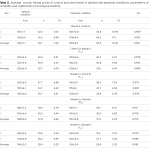
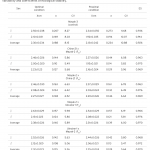
|
129 - 133 |
| Some Characteristic Properties of Chestnut and Rhododendron Honeys in Turkey Chestnut (Castanea sativa Mill.) and Rhododendron (Rhododendron spp. L.) (mad honey) honeys are produced generally in Black Sea Region in Turkey and both of them are the special honeys because of their organic component content and known their high antioxidant capacity. In the first step of this study we researched the melissopalynological differentiation of the chestnut and rhododendron honeys and then in the second step we determined the chemical compounds and sugar content of the rhododendron, chestnut and mixed chestnut&rhododendron honeys. For this purpose total 18 honey samples were collected from 4 different districts from Black Sea Region of Turkey and melissopalynological analyses were done by microscope. Chemical composition and sugar content (fructose&glucose) were determined by High Performance Liquid Chromatograpy (HPLC) and Gas Chromatography-Mass Spectrometry (GC-MS). After melissopalynological anaylses were obtained 10 monofloral chestnut, 2 monofloral rhododendron and 6 mixed chestnut&rhododendron honeys. As a result of sugar analysis with HPLC, F/G rates were found between 1.17 and 1.80. GC-MS chemical substance analyses of honeys revealed alcohols, aldehydes, ketones, aliphatic acids and their esters, carboxylic acids and their esters and flavanonoids. 
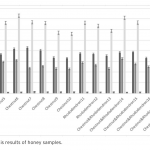
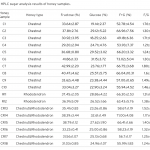
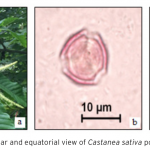
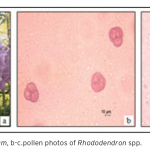
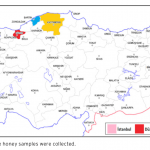
|
135 - 145 |